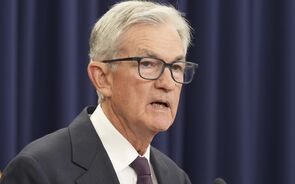ainda o caso preço do petróleo...
2 mensagens
|Página 1 de 1
Rápido, queremos esses preços em Portugal !
Se a gosolina chagar a esses valores no verão e nos States, cá deverá ir a 1,20/1,25 euros/litro isto se a Manela não se lembrar de aumentar o imposto
isto se a Manela não se lembrar de aumentar o imposto 
Agora a sério, quanto mais o petróleo sobe, mais ganham as petrolíferas. Só há 2 soluções: ou gastar menos, ou gastar outra coisa (o quê?)
Se a gosolina chagar a esses valores no verão e nos States, cá deverá ir a 1,20/1,25 euros/litro
Agora a sério, quanto mais o petróleo sobe, mais ganham as petrolíferas. Só há 2 soluções: ou gastar menos, ou gastar outra coisa (o quê?)
... em formação... sempre!
ainda o caso preço do petróleo...
Hoje lá saiu mais um "inform" do Energy Department dos States, e que veio dar continuação ao encarecimento do petróleo nos mercados de crude.
Mas o mais engraçado disto tudo é que nos States a gasolina anda a preços arrepiantes... e que pode ir a 1.76 dollars/galão.... ou seja... prai 40 cêntimos/litro.
Digam lá que os portugeses não têm mesmo de fazer 'milagres', quando têm das gasolinas mais caras da europa...hum?
Fica o artigo sobre o caso States:
Caution: summer gas-price spike ahead
U.S. agency says retail prices to average $1.76 a gallon
By Myra P. Saefong, CBS.MarketWatch.com
Last Update: 8:44 AM ET April 8, 2004
SAN FRANCISCO (CBS.MW) -- The price for a gallon of regular unleaded gasoline will average $1.76 per gallon this summer, 20 cents higher than last year, the Energy Department said Thursday.
Some analysts, however, believe prices will average as high as $3 per gallon in some states on the back of rising demand and crude-oil prices. But such a price spike isn't expected to be widespread, they said.
The high price of crude, which touched a 13-year high above $38 per barrel on the New York Mercantile Exchange in mid-March, is among the biggest reasons for the increase in regular unleaded gas to record highs ahead of the summer driving season.
Prices for a gallon of the regular unleaded grade stood at $1.771 per gallon as of Thursday, just off the all-time record of 1.773 set on Wednesday, according to the AAA's daily fuel gauge report.
High crude costs, strong gasoline demand, low gasoline inventories and stricter regional gasoline specifications all contributed to record-high pump prices before the summer driving season even began, said the Energy Information Administration, an arm of the Energy Department.
In a pair of reports -- the annual "Summer Gasoline Outlook" and monthly "Short-Term Energy Outlook" -- the EIA warned that the domestic gasoline supply system is vulnerable to "severe price shocks" if major refinery or pipeline outages occur. The threat of higher pump prices could be mitigated, however, if crude prices decline more quickly than expected and gas import volumes improve from levels seen so far this year, the EIA said.
Some months could see average pump prices at or above $1.80 a gallon, the agency warned. Motor gasoline demand is projected to average 9.32 million barrels a day, a new high, the summer gas outlook report said.
Demand has been increasing on an annual basis as the number of drivers and vehicles keeps pace with population growth, the report said. Average fleet-wide fuel efficiency was virtually unchanged from last year, the EIA said.
Mulling waivers
In the last week, the petroleum market has been assessing the odds of a summer requirement waiver from the Environmental Protection Agency on certain environmentally stringent blends of gasoline in some states.
Last Thursday, Energy Secretary Spencer Abraham said the EPA is considering waiving some requirements on gasoline in certain states -- a move that could help boost production at the refinery level.
"It would take a federal waiver exempting California from clear-air rules for gasoline to lower prices and increase refineries' flexibility in producing gasoline and lower consumer costs," said John Person, head financial analyst at Infinity Brokerage Services.
Gasoline prices have soared to record highs as refiners passed along higher costs for crude oil, which accounts for more than two-fifths of the retail price of the fuel, he said.
Added to that, the Organization of Petroleum Countries lowered its production quota by 1 million to 23.5 million barrels this month.
More political pressure
Most analysts believe that in the very least, the Bush administration is faced with a dilemma of a no-win situation in the middle of an election year.
President Bush "has a 3,000-pound elephant on his back -- cut emissions requirements and expensive blending to lower prices but make the environmentalists angry, or try to ride out high prices and be blamed for a terrible energy policy," said Kerr.
"It is really a no-win," he said.
Tom Kloza, chief oil analyst at The Oil Price Information Service, expects the Energy Department to lean toward some sort of a temporary waiver of the clean-air blend rules "so that more European and domestic fuel could be used at the end of the summer."
Demand prospects
As the political pressure to lower consumer prices rages on, demand continues to be "spectacular" -- up 3 percent to 4 percent over the last year in the last six weeks or so, said Kloza.
What's likely happening is a combination of things, he said. The market is probably seeing additional gasoline stocks going into non-reported storage and driving usage is increasing with the strengthening economy, he said.
However, the demand increases of as much as 4 percent that the market has been seeing "are not sustainable," he said, adding that demand growth will likely fall to 1.5 percent to 2 percent.
Kevin Kerr, editor of the investor newsletter Kwest Market Edge, disagrees. He believes there's a bigger inventory dilemma ahead.
"This problem won't end just when the summer driving season ends," he said. "Refiners will start gearing up again for heating-oil production before you know it."
"If one refinery is attacked, if one pipeline blows up, if one more major incident of terrorism rears its ugly head, oil ... has the potential to skyrocket," he said.
Price targets
Against the backdrop of rising demand, political and consumer pressure and the upcoming summer season, gasoline prices at the pump are poised to continue hitting record highs.
Kloza said prices are already close to the first-half 2004 peak, which he estimates at $1.76 to $1.78. From here, he expects prices to move up 10 cents to 15 cents through June.
In August, the price will climb top $1.80 to $1.90, and maybe even $2.25 in California, he said. "That'll be short-lived, however, since we will be manufacturing and importing more gasoline than we use once we get into the middle of September," he said.
The market may see some $3 gasoline prices, but they'll only be the "quirky exception of the occasional dealer," Kloza said, emphasizing that "the chances of having to pay a minimum or an average of $3 per gallon gasoline in your neighborhood are nil."
Kerr said "realistic prices put gasoline at around the $2.20 to $2.50 range" for the summer, said Kerr.
However, "any major disruption, higher-than-expected demand, further cuts by OPEC etc. -- and you could still see $3," in certain states, he said.
Still, he pointed out that the Bush administration "will pull out all the stops to prevent that - it would be political suicide otherwise."
California, New York and Connecticut are among those states with the biggest chance for $3 gas, according to John Kilduff, an analyst at Fimat USA.
"A single refinery snafu of any significance would enable the national average to exceed $2 per gallon," he said. Read a related story.
"The current conditions are producing the highest 'refinery roulette' stakes ever, and so far, consumers have experienced their fair share of double-zero rolls," he added.
Mas o mais engraçado disto tudo é que nos States a gasolina anda a preços arrepiantes... e que pode ir a 1.76 dollars/galão.... ou seja... prai 40 cêntimos/litro.
Digam lá que os portugeses não têm mesmo de fazer 'milagres', quando têm das gasolinas mais caras da europa...hum?
Fica o artigo sobre o caso States:
Caution: summer gas-price spike ahead
U.S. agency says retail prices to average $1.76 a gallon
By Myra P. Saefong, CBS.MarketWatch.com
Last Update: 8:44 AM ET April 8, 2004
SAN FRANCISCO (CBS.MW) -- The price for a gallon of regular unleaded gasoline will average $1.76 per gallon this summer, 20 cents higher than last year, the Energy Department said Thursday.
Some analysts, however, believe prices will average as high as $3 per gallon in some states on the back of rising demand and crude-oil prices. But such a price spike isn't expected to be widespread, they said.
The high price of crude, which touched a 13-year high above $38 per barrel on the New York Mercantile Exchange in mid-March, is among the biggest reasons for the increase in regular unleaded gas to record highs ahead of the summer driving season.
Prices for a gallon of the regular unleaded grade stood at $1.771 per gallon as of Thursday, just off the all-time record of 1.773 set on Wednesday, according to the AAA's daily fuel gauge report.
High crude costs, strong gasoline demand, low gasoline inventories and stricter regional gasoline specifications all contributed to record-high pump prices before the summer driving season even began, said the Energy Information Administration, an arm of the Energy Department.
In a pair of reports -- the annual "Summer Gasoline Outlook" and monthly "Short-Term Energy Outlook" -- the EIA warned that the domestic gasoline supply system is vulnerable to "severe price shocks" if major refinery or pipeline outages occur. The threat of higher pump prices could be mitigated, however, if crude prices decline more quickly than expected and gas import volumes improve from levels seen so far this year, the EIA said.
Some months could see average pump prices at or above $1.80 a gallon, the agency warned. Motor gasoline demand is projected to average 9.32 million barrels a day, a new high, the summer gas outlook report said.
Demand has been increasing on an annual basis as the number of drivers and vehicles keeps pace with population growth, the report said. Average fleet-wide fuel efficiency was virtually unchanged from last year, the EIA said.
Mulling waivers
In the last week, the petroleum market has been assessing the odds of a summer requirement waiver from the Environmental Protection Agency on certain environmentally stringent blends of gasoline in some states.
Last Thursday, Energy Secretary Spencer Abraham said the EPA is considering waiving some requirements on gasoline in certain states -- a move that could help boost production at the refinery level.
"It would take a federal waiver exempting California from clear-air rules for gasoline to lower prices and increase refineries' flexibility in producing gasoline and lower consumer costs," said John Person, head financial analyst at Infinity Brokerage Services.
Gasoline prices have soared to record highs as refiners passed along higher costs for crude oil, which accounts for more than two-fifths of the retail price of the fuel, he said.
Added to that, the Organization of Petroleum Countries lowered its production quota by 1 million to 23.5 million barrels this month.
More political pressure
Most analysts believe that in the very least, the Bush administration is faced with a dilemma of a no-win situation in the middle of an election year.
President Bush "has a 3,000-pound elephant on his back -- cut emissions requirements and expensive blending to lower prices but make the environmentalists angry, or try to ride out high prices and be blamed for a terrible energy policy," said Kerr.
"It is really a no-win," he said.
Tom Kloza, chief oil analyst at The Oil Price Information Service, expects the Energy Department to lean toward some sort of a temporary waiver of the clean-air blend rules "so that more European and domestic fuel could be used at the end of the summer."
Demand prospects
As the political pressure to lower consumer prices rages on, demand continues to be "spectacular" -- up 3 percent to 4 percent over the last year in the last six weeks or so, said Kloza.
What's likely happening is a combination of things, he said. The market is probably seeing additional gasoline stocks going into non-reported storage and driving usage is increasing with the strengthening economy, he said.
However, the demand increases of as much as 4 percent that the market has been seeing "are not sustainable," he said, adding that demand growth will likely fall to 1.5 percent to 2 percent.
Kevin Kerr, editor of the investor newsletter Kwest Market Edge, disagrees. He believes there's a bigger inventory dilemma ahead.
"This problem won't end just when the summer driving season ends," he said. "Refiners will start gearing up again for heating-oil production before you know it."
"If one refinery is attacked, if one pipeline blows up, if one more major incident of terrorism rears its ugly head, oil ... has the potential to skyrocket," he said.
Price targets
Against the backdrop of rising demand, political and consumer pressure and the upcoming summer season, gasoline prices at the pump are poised to continue hitting record highs.
Kloza said prices are already close to the first-half 2004 peak, which he estimates at $1.76 to $1.78. From here, he expects prices to move up 10 cents to 15 cents through June.
In August, the price will climb top $1.80 to $1.90, and maybe even $2.25 in California, he said. "That'll be short-lived, however, since we will be manufacturing and importing more gasoline than we use once we get into the middle of September," he said.
The market may see some $3 gasoline prices, but they'll only be the "quirky exception of the occasional dealer," Kloza said, emphasizing that "the chances of having to pay a minimum or an average of $3 per gallon gasoline in your neighborhood are nil."
Kerr said "realistic prices put gasoline at around the $2.20 to $2.50 range" for the summer, said Kerr.
However, "any major disruption, higher-than-expected demand, further cuts by OPEC etc. -- and you could still see $3," in certain states, he said.
Still, he pointed out that the Bush administration "will pull out all the stops to prevent that - it would be political suicide otherwise."
California, New York and Connecticut are among those states with the biggest chance for $3 gas, according to John Kilduff, an analyst at Fimat USA.
"A single refinery snafu of any significance would enable the national average to exceed $2 per gallon," he said. Read a related story.
"The current conditions are producing the highest 'refinery roulette' stakes ever, and so far, consumers have experienced their fair share of double-zero rolls," he added.
-
Info.
2 mensagens
|Página 1 de 1
Quem está ligado:
Utilizadores a ver este Fórum: Google [Bot], Pmart 1 e 128 visitantes


